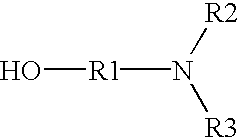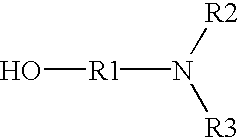Antimicrobial paste glues
a technology of antimicrobial paste and glue, which is applied in the direction of adhesive additives, adhesive types, coatings, etc., can solve the problems of affecting the health of consumers, affecting the quality of water, drinks or foods, and affecting the quality of products
- Summary
- Abstract
- Description
- Claims
- Application Information
AI Technical Summary
Benefits of technology
Problems solved by technology
Method used
Image
Examples
example 1
[0048] 0.6 g of 2-tert-butylaminoethanol are mixed with 3.4 g of TTW Normal paste glue (Wilke, Magdeburg). 280 ml of water are added to this mixture, and the mixture is then stirred for 1 hour. 5 g of the resultant paste glue mixture are spread onto an aluminum plate of dimensions 20.times.40 cm and then dried for a period of 72 hours at 30.degree. C.
example 1a
[0049] A section of dimensions 2.times.3 cm from the coated aluminum plate of example 1 is placed on the base of a glass beaker which contains 10 ml of a test microbial suspension of Pseudomonas aeruginosa. The system prepared in this way is then shaken for a period of 4 hours. 1 ml of the test microbial suspension is then removed. After expiration of this period, the number of microbes has fallen from 10.sup.7 to 10.sup.2 per ml.
example 1b
[0050] A section of dimensions 2.times.3 cm from the coated aluminum plate of example 1 is placed on the base of a glass beaker which contains 10 ml of a test microbial suspension of Staphylococcus aureus. The system prepared in this way is then shaken for a period of 4 hours. 1 ml of the test microbial suspension is then removed. After expiration of this period, no remaining Staphylococcus aureus microbes are detectable.
PUM
| Property | Measurement | Unit |
|---|---|---|
| Percent by mass | aaaaa | aaaaa |
| Weight | aaaaa | aaaaa |
| Volume | aaaaa | aaaaa |
Abstract
Description
Claims
Application Information
 Login to View More
Login to View More - R&D
- Intellectual Property
- Life Sciences
- Materials
- Tech Scout
- Unparalleled Data Quality
- Higher Quality Content
- 60% Fewer Hallucinations
Browse by: Latest US Patents, China's latest patents, Technical Efficacy Thesaurus, Application Domain, Technology Topic, Popular Technical Reports.
© 2025 PatSnap. All rights reserved.Legal|Privacy policy|Modern Slavery Act Transparency Statement|Sitemap|About US| Contact US: help@patsnap.com


